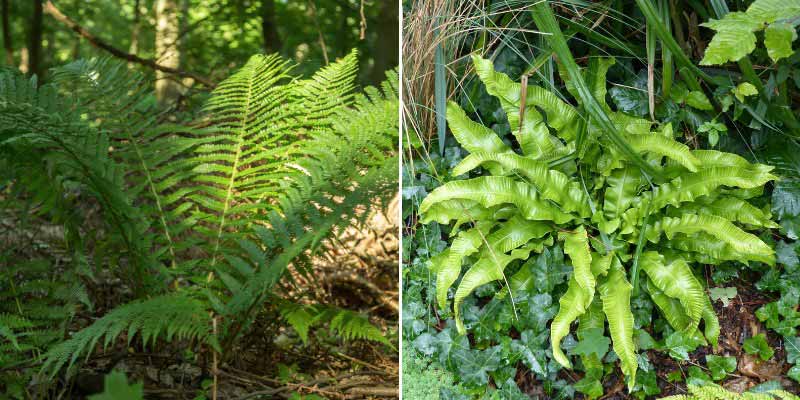With their large, finely divided feathery fronds, ferns are perfect for adding exuberance and graphic interest to shady or neglected corners of the garden. They thrive in shade and in rich, moist soil. Hardy and vigorous, ferns require little maintenance. Evergreen ferns need only light maintenance, whereas deciduous ones require more regular pruning. Pruning ferns helps maintain a neat appearance and encourages growth of new fronds. Here’s how to successfully prune your fern!
Ferns in a nutshell
Plants of the Pteridophyta group, ferns represent an extremely diverse plant family, with between 9,000 and 13,000 species found on almost every continent. Although most ferns originate from tropical zones, where they are often grown as houseplants, many hardy species thrive in temperate regions, notably in France, where they grow naturally in woodland and damp forests. In the wild you can encounter the male fern (Dryopteris filix-mas) or the hart's‑tongue fern (Asplenium scolopendrium), which grow naturally in moist, shady environments.
Ferns display a wide variety of forms. Some develop in erect clumps, sometimes forming true stipes (trunks) for arborescent species, such as Dicksonia. Others, known as spreading ferns, expand via running rootstocks that allow them to cover the ground.
The size of ferns varies considerably by species. For example, Asplenium are among the smallest, with a low habit, while Dryopteris, such as the male fern (Dryopteris filix-mas), are more imposing and offer generous foliage. Osmunda regalis, or royal fern, is one of the most impressive hardy species, reaching up to two metres in height.
Which ferns to prune?
Ferns surprise with their diversity. Not all ferns require the same attention when it comes to pruning. Ferns fall into two main categories:
- Deciduous ferns: these are ones that lose their leaves in winter, such as bracken (Pteridium aquilinum) or the male fern (Dryopteris filix-mas). Their brown, withered foliage should be cut back each year to encourage development of new fronds.
- Evergreen ferns: those that retain their foliage year‑round, such as the hart's‑tongue fern (Asplenium scolopendrium) or Polystichum setiferum. For these varieties, light pruning is sufficient to remove damaged fronds.

When to prune a fern?
Pruning of deciduous ferns is generally carried out in late winter or early spring, before new fronds appear. This clears space for young shoots while leaving dead fronds to protect the plant over winter. For evergreen ferns, pruning should be done in early spring, before the plant begins to produce new leaves. You can also remove damaged or yellowing fronds at any time of year if necessary.

How to prune fern fronds?
Equipment needed:
- a sharp pruning shear cleaned with alcohol beforehand to avoid risk of disease transmission
- a pair of gloves
Pruning ferns is relatively simple, but it must be done with care so as not to damage the plant. Old fronds protect young shoots from the cold, notably the small croziers at the centre of the clump; in cold regions, take care not to prune too early.
- Using the pruning shear, cut fronds at the base, close to the ground, for deciduous ferns. Avoid breaking fronds by hand to prevent pulling out roots. Also take care not to prune young shoots or croziers, recognisable by their curled shape, as they will produce the new fronds.
- Remove only dead, withered or damaged fronds for evergreen ferns. Healthy fronds should be kept to allow the plant to continue developing.
- After pruning, you can mulch the base of ferns to protect young shoots and retain soil moisture, especially in spring.

Special case: pruning tree ferns
Pruning tree ferns differs slightly from pruning regular ferns. These ferns, which develop a trunk called a stipe, such as Dicksonia antarctica, require gentler pruning. It is recommended to remove only faded or damaged fronds located at the base of the trunk. Fronds of tree ferns should be left on the stipe as long as they remain green, since they contribute to the plant’s growth. Once cut, dead fronds can also help protect the crown and trunk from cold in winter.
































Comments